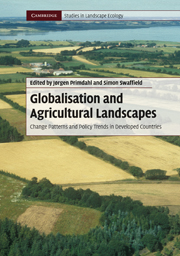Book contents
- Frontmatter
- Contents
- List of Contributors
- Preface
- 1 Globalisation and the sustainability of agricultural landscapes
- 2 Agricultural liberalisation, multifunctionality and the WTO: competing agendas for the future of farmed landscapes
- 3 Globalisation of agricultural landscapes: a land systems approach
- 4 Agricultural landscape changes through globalisation and biodiversity effects
- 5 Swiss agricultural policy reform: landscape changes in consequence of national agricultural policy and international competition pressure
- 6 Local landscape consequences of macro-scale policy reform: the New Zealand experiment
- 7 Rural landscape differentiation in the face of changing demands and policies: a typology of rural areas in Portugal
- 8 Globalisation and the local agricultural landscape: current change patterns and public policy interventions
- 9 From totalitarian to democratic landscapes: the transition in Estonia
- 10 Rural landscape change as a product of US federal policy
- 11 New approaches for urban–rural areas in Dutch spatial planning
- 12 Restoring agricultural landscapes in shrinking cities: re-inventing traditional concepts in Japanese planning
- 13 Globalisation and local agricultural landscapes: patterns of change, policy dilemmas and research questions
- Index
- References
12 - Restoring agricultural landscapes in shrinking cities: re-inventing traditional concepts in Japanese planning
Published online by Cambridge University Press: 05 June 2012
- Frontmatter
- Contents
- List of Contributors
- Preface
- 1 Globalisation and the sustainability of agricultural landscapes
- 2 Agricultural liberalisation, multifunctionality and the WTO: competing agendas for the future of farmed landscapes
- 3 Globalisation of agricultural landscapes: a land systems approach
- 4 Agricultural landscape changes through globalisation and biodiversity effects
- 5 Swiss agricultural policy reform: landscape changes in consequence of national agricultural policy and international competition pressure
- 6 Local landscape consequences of macro-scale policy reform: the New Zealand experiment
- 7 Rural landscape differentiation in the face of changing demands and policies: a typology of rural areas in Portugal
- 8 Globalisation and the local agricultural landscape: current change patterns and public policy interventions
- 9 From totalitarian to democratic landscapes: the transition in Estonia
- 10 Rural landscape change as a product of US federal policy
- 11 New approaches for urban–rural areas in Dutch spatial planning
- 12 Restoring agricultural landscapes in shrinking cities: re-inventing traditional concepts in Japanese planning
- 13 Globalisation and local agricultural landscapes: patterns of change, policy dilemmas and research questions
- Index
- References
Summary
Introduction
In Japan, the effects of the globalisation of agriculture are particularly acute. For decades, the government has attempted to maintain the viability of domestic agriculture through protectionist policies and subsidies. Yet despite these policies, food consumption in Japan is increasingly global and domestic agriculture is increasingly less viable. High production costs, combined with a decreasing and rapidly ageing population, create a situation where most farm households are successor-less, and the future of domestic agriculture is in question. Against this backdrop, the nation's self-sufficiency rate has sunk below 40%, as a wide range of staple agricultural products are increasingly imported from around the world (seeFigures 12.1 and 12.2).
At the same time, the globalisation of food consumption and declining viability of domestic agriculture has produced its own crises and counter-movements. Most notable in recent years is the increasing sense of fear and vulnerability produced by the decreasing self-sufficiency rate and food scandals over tainted imports. For example, in January 2008 over 400 people were poisoned after consuming frozen dumplings from China tainted with pesticides. The incident produced a backlash against frozen imports and plummeting sales (Japan Times, 2008). In general, the government's response to food scandals and declining domestic production has been to promote the intensification of industrial agriculture, particularly rice production, to raise the nation's caloric self-sufficiency rate.
However, the central government's push to raise self-sufficiency is not the only counter-movement shaping agriculture in Japan.
- Type
- Chapter
- Information
- Globalisation and Agricultural LandscapesChange Patterns and Policy trends in Developed Countries, pp. 225 - 244Publisher: Cambridge University PressPrint publication year: 2010
References
- 4
- Cited by



